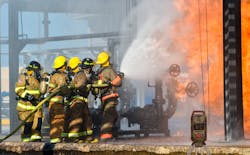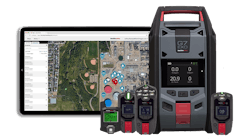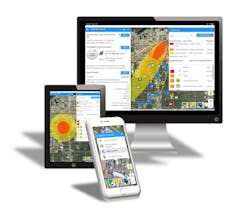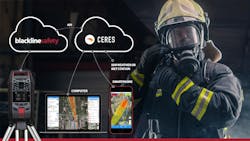Expert Insights: Connected Gas Detection Coupled with Dispersion Modeling: A Giant Leap for Hazmat Responses
Across the U.S., 17% of the population live near a toxic release facility, ranging from 6.5% in Hawaii to 37.3% in Wisconsin (Stacker.com). That means 56 million Americans live close to a facility that uses or manufactures any of the 770 chemicals recognized by the EPA to have negative health implications.
Hazardous material releases can have dramatic and lasting effects on first responders, communities, and businesses. Managing those events requires an immediate response with a well-thought-out strategy, and effective teamwork. When lives are on the line, seconds matter, and having quick access to information is crucial.
If you’ve ever thought about the potential impact that a larger incident might have on communities, including schools, churches, office buildings, etc., then you have likely wondered how to best protect them from harm during and after such an incident. Hazmat emergency responders know how important it is to have the right tools and develop training programs in advance of such an incident. However, many don’t realize that two of the most trusted tools—gas detectors and plume dispersion modeling software—now work together and provide complementary benefits as first responder tools.
Connected gas detection and Hazmat response
The shift toward cloud-connected devices has eliminated many of the old pain points of using conventional gas detectors. For example, Hazmat response operations require quick access to live monitoring of an incident’s conditions and responder’s locations to ensure informed decisions can be made. However, many conventional gas detectors only send a screenshot of the situation at set intervals; they don’t provide live data.Online dashboards, cloud-connected area monitors, and personal wearable devices create a network that gives incident commanders and resource scientists immediate access to critical information across the entire network. For example, equipment managers can now check bump and calibration dates, battery levels, and device location from anywhere globally. They no longer need to chase down devices and wait to connect them to a dock before they get the information they need.
Satellite and/or cellular-connected devices mean you have a redundant connection available, never losing track of the location of your responders and the atmospheric conditions where they are during an emergency. These types of communications also eliminate the hit or miss of Mesh networks, inherent Bluetooth limitations, and those relying on “gateways” as intermediary connection points. In addition, location tracking lets you develop effective rescue plans and reduce the risk to responders.
People need accurate data to make informed decisions while responding to an incident. Having online dashboards lets you share access to live reports and quickly update multiple groups. That means everyone gets the information they need when they need it, reducing bottlenecks in decision making.
(Read: Fire Department Uses Gas Detectors to Save Lives)One might assume that connected gas detection devices are complicated to use, hard to set up, and prone to damage. However, Blackline Safety’s connected gas detectors have a user-friendly interface, are automatically connected to the cloud within seconds of being turned on and are designed to withstand the harshest environments. With all these benefits, changing from conventional gas detectors to connected gas detection devices is a no-brainer for first responders.
Plume modeling and Hazmat response
If you’re not already familiar with them, plume dispersion models are computer-based tools used to predict the path and concentration of airborne contaminants and toxic gases following a release. Users enter details about actual or possible chemical releases, and the program will calculate potential threat zones in the surrounding area. Emergency responders can then use these predictions to make informed emergency management decisions like whether surrounding communities should shelter in place or need to evacuate.When Gas Detection and Plume Modeling combine
On their own, connected gas detection devices and plume modeling are essential tools for any incident response team. However, when combined, they become a game-changer for Hazmat responses. That's why Blackline Safety has partnered with Vlahi Systems to integrate the real-time, location-enabled data from Blackline’s G7 personal and area gas detectors into Vlahi’s CERES web and smartphone-based plume modeling software.
Chemical Emergency Response E-Service (CERES) from Vlahi Systems is incident response software that makes dispersion modeling more accurate and effective. CERES uses ALOHA hazard modeling developed by the US government and combines it with google maps integration, live meteorological data, and sensor-driven plume modeling. Real-time data from gas detectors, weather readings, and GPS devices means the CERES algorithm can provide the most accurate predictions possible. This vital data helps Hazmat personnel plan for, respond to, and analyze toxic chemical, fire, and explosion events. And if radiation is also a concern, think about the possibilities of integrating what PRDs you already own; there may just be a solution to make the best use of your existing assets.As a result of the real-time data and plume modeling, you can know with confidence if an area is safe or to sound the alarm when gas levels have exceeded an unsafe threshold. In addition, response leaders can immediately notice changes in concentrations and shifts in weather patterns, allowing the identification of at-risk areas faster than ever before.
Summary
When the health and safety of first responders and communities are on the line, the more you know, the better. Combining connected gas detectors like Blackline Safety’s G7 EXO Area Monitor or G7c gas detectors with Vlahi’s CERES predictive plume modeling, you have the most accurate information available to make confident, informed decisions during Hazmat responses.
For more information and resources:













